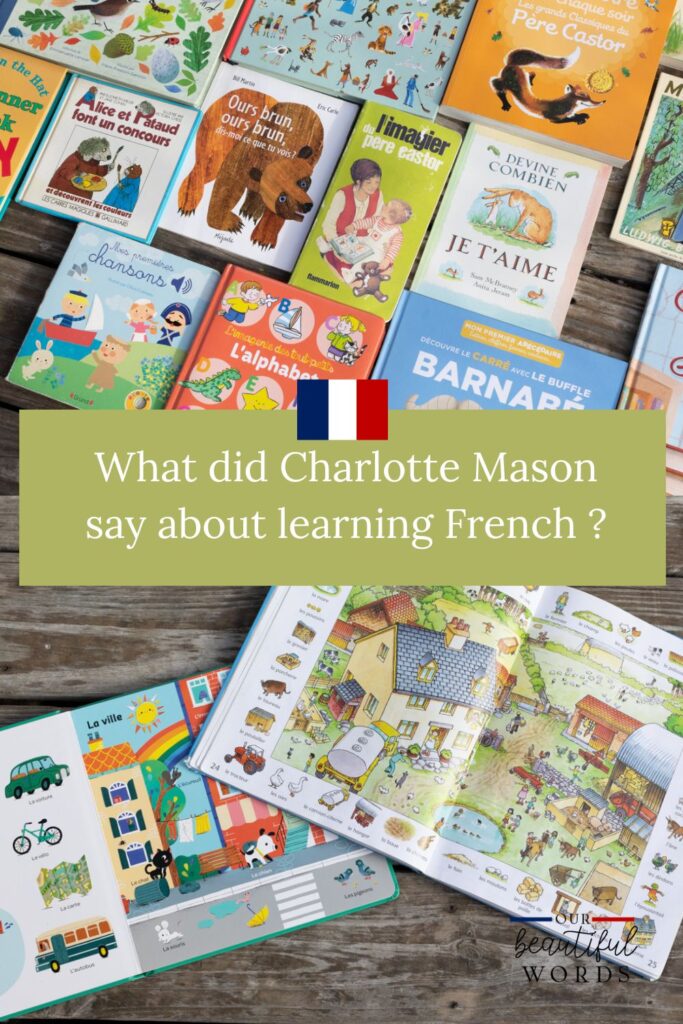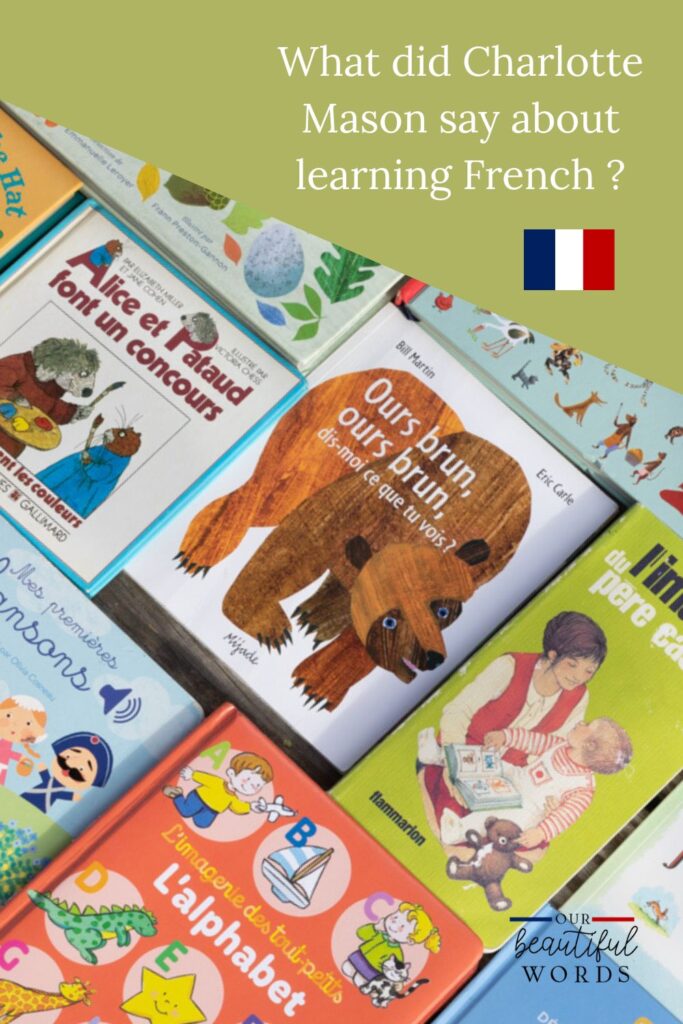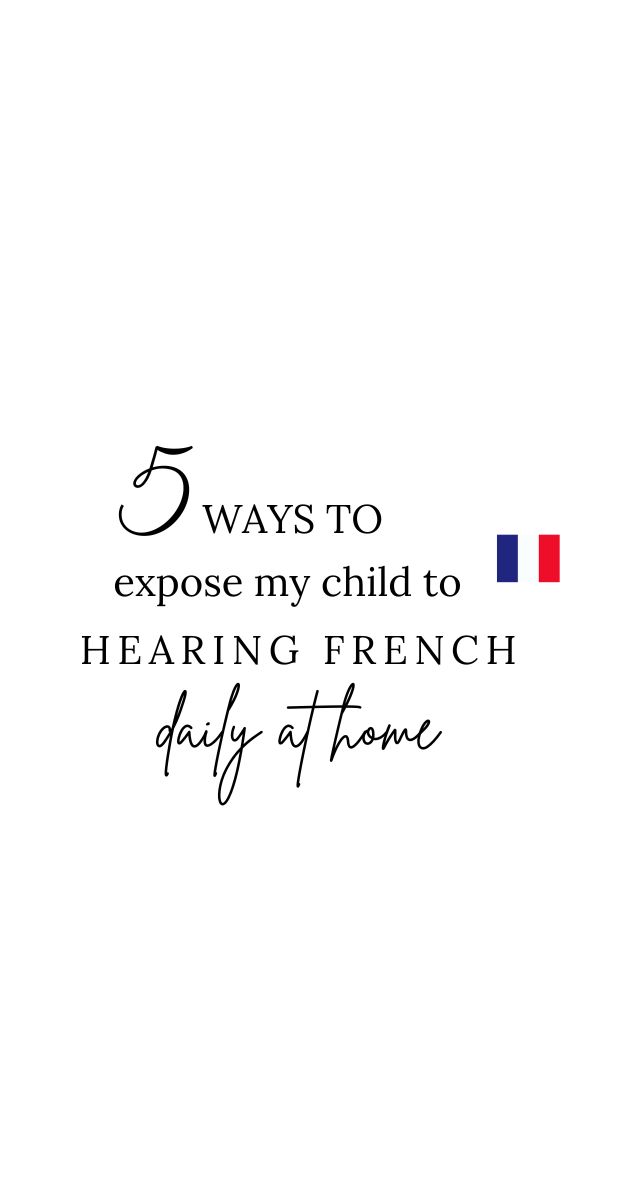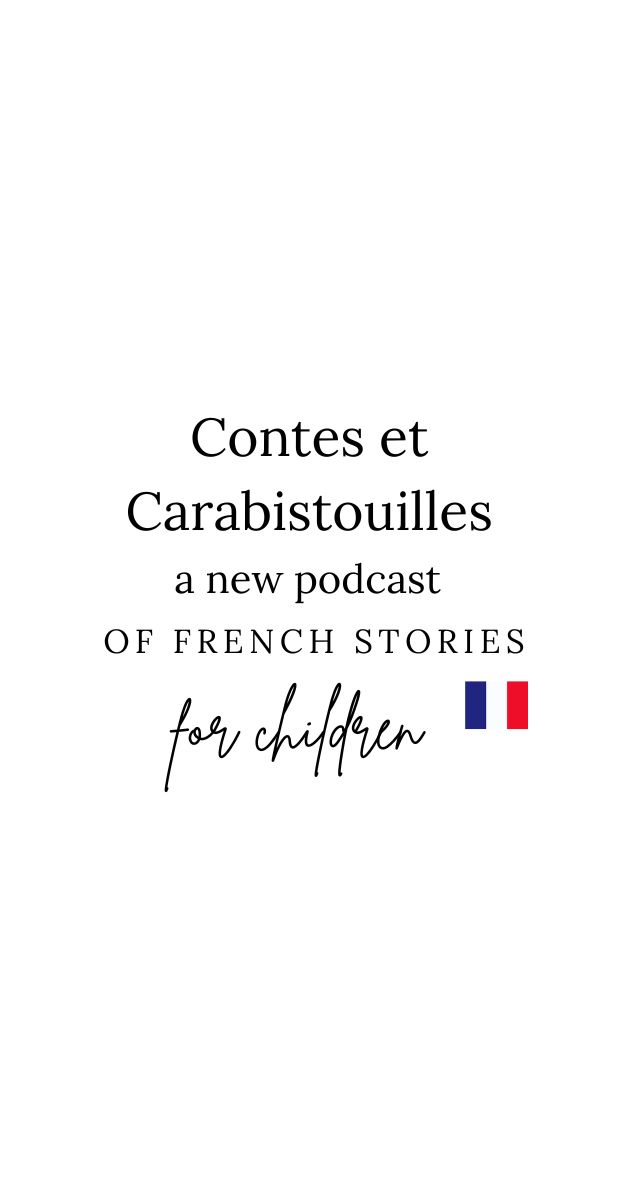Charlotte Mason wrote multiple times about learning foreign languages in Volume 1 – Home Education, she also mentions it in Volume 6. In this article, I gathered the relevant passages so that you can understand her point of view on the matter.
Volume 1
The French Lesson.––The daily French lesson is that which should not be omitted. That children should learn French orally, by listening to and repeating French words and phrases; that they should begin so young that the difference of accent does not strike them, but they repeat the new French word all the same as if it were English and use it as freely; that they should learn a few––two or three, five or six––new French words daily, and that, at the same time, the old words should be kept in use––are points to be considered more fully hereafter: in the meantime, it is so important to keep tongue and ear familiar with French vocables, that not a lesson should be omitted. The French lesson may, however, be made to fit in with the spirit of the other out-of-door occupations; the half-dozen words may be the parts––leaves, branches, bark, trunk of a tree, or the colours of the flowers, or the movements of bird, cloud, lamb, child; in fact, the new French words should be but another form of expression for the ideas that for the time fill the child’s mind. (p.80-81 XI. Out of Door Games, etc.)
French should be acquired as English is, not as a grammar, but as a living speech. To train the ear to distinguish and the lips to produce the French vocables is a valuable part of the education of the senses, and one which can hardly be undertaken too soon. Again, all educated persons should be able to speak French. Sir Lyon Playfair, once speaking a conference of French masters, lamented feelingly our degeneracy in this respect, and instanced the grammar school of Perth to show that in a Scotch school in the sixteenth century the boys were required to speak Latin during school hours, and French at all other times. There is hardly another civilised nation so dull in acquiring foreign tongues as we English of the present time; but, probably, the fault lies rather in the way we set about the study than in any natural incapacity for languages.
As regards French, for instance, our difficulties are twofold––the want of a vocabulary, and a certain awkwardness in producing unfamiliar sounds. It is evident that both these hindrances should be removed in early childhood. The child should never see French words in print until he has learned to say them with as much ease and readiness as if they were English. The desire to give printed combinations of letters the sounds they would bear in English words is the real cause of our national difficulty in pronouncing French. Again, the child’s vocabulary should increase steadily, say, at the rate of half a dozen words a day. Think of fifteen hundred words in a year! The child who has that number of words, and knows how to apply them, can speak French. Of course, his teacher, will take care that, in giving words, she gives idioms also, and that as he learns new words, they are put into sentences and kept in use from day to day. A note-book in which she enters the child’s new words and sentences will easily enable the teacher to do this. The young child has no foolish shame about saying French words––he pronounces them as simply as if they were English. But it is very important that he should acquire a pure accent from the first. It is not often advisable that young English children should be put into the hands of a French governess or nurse; but would it not be possible for half a dozen families, say, to engage a French lady, who would give half an hour daily to each family?
M. Gouin’s Method––A serious effort is being made to approach the study of foreign languages rationally and scientifically. I have no hesitation in saying that M. [Monsieur Francois] Gouin’s work (The Art of Teaching and Studying Languages) is the most important attempt that has yet been made to bring the study of languages within the sphere of practical education. Indeed, the great reform in our methods of teaching modern languages owe their origin to this remarkable work. The initial idea, that we must acquire a new language as a child acquires his mother tongue, is absolutely right, whether the attempt to follow this idea out by analysing a language into a certain number, say fifteen, exhaustive ‘series,’ be right or not. Again, it is incontestable that the ear, and not the eye, is the physical organ for apprehending a language, just as truly as it is by the mouth, and not the ear, we appropriate food. If M. Gouin’s book establish these two points only, it will be a valuable contribution to educational thought. Equally important is his third position, that the verb is the key to the sentence, and more, is the living bridge between thought and act. He maintains, too, that the child thinks in sentences, not in words; that his sentences have a logical sequence; that this sequence is one of time ––the order of the operations in, for example, the growth of a plant, or the grinding of corn in a mill; that, as the child perceives the operations, he has an absolute need to express them; that his ear solicits, his memory cherishes, his tongue reproduces, the words which say the thing he thinks.
No doubt M. Gouin’s method should be more successful than any other in steeping the student (child or man) in German or French thought. If you are all day long trying to work out a ‘series’ in French, say, you come to think in French, to dream in French, to speak French. Moreover, one has a delightful sense that at last the way is made clear to us to conduct all teaching in the language under study. You have the ‘Art Series’ and the ‘Bee Series’ and the ‘River’ and the ‘Character Series’ and the ‘Poet Series,’ and any series you like. You think the thing out in the order of time and natural sequence; you get the right verbs, nouns, and such epithets as are necessary, follow suit, and in amazingly few sentences, very short sentences too, connected by ‘and,’ you have said all that is essential to the subject. The whole thing is a constant surprise, like the children’s game which unearths the most extraordinary and out-of-the-way thing you can think of by means of a dozen or so questions.
The ‘Series.’––Thus, a language learned by M. Gouin’s method is ‘a liberal education in itself.’ One learns how few and simple are, after all, the conceptions of which the human mind is cognisant, and how few and simple, putting mere verbiage aside, are the words necessary to express these. You really learn to think in the new language, because you have no more than vague impressions about these acts or facts in your mother tongue. You order your thoughts in the new language, and, having done so, the words which express these are an inalienable possession.
Here is an example of an elementary ‘Series,’ showing how ‘the servant lights the fire’:
“The servant takes a box of matches, (takes.)
She opens the match-box, (opens.)
She takes out a match, (takes out.)
She shuts up the match-box, (shuts up.)
She strikes the match on the cover, (strikes.)
The match takes fire, (takes fire.)
The match smokes, (smokes.)
The match flames, (flames.)
The match burns, (burns.)
And spreads a smell of burning over the kitchen, (spreads.)
The servant bends down to the hearth, (bends down.)
Puts out her hand, (puts out.)
Puts the match under the shavings, (puts.)
Holds the match under the shavings, (holds.)
The shavings take fire, (take fire.)
The servant leaves go of the match, (leave go.)
Stands up again, (stands up.)
Looks at her fire burning, (looks.)
And puts back the box of matches in its place, (puts back.)But any attempt to quote gives an uncertain and unsatisfactory idea of this important work.
How does the Child learn?––Whatever may be said of M. Gouin’s methods, the steps by which he arrives at them are undoubtedly scientific. He learns from a child:
“Unhappily the child has remained up to the present a hackneyed riddle, which we have never taken sufficient trouble to decipher or examine. . .”
The little child, which at the age of two years utters nothing but meaningless exclamations, at the age of three finds itself in possession of a complete language. How does it accomplish this? Does this miracle admit of explanation or not? Is it a problem of which there is a possibility of finding the unknown quantity? . . . The organ of language––ask the little child––is not the eye: it is the ear. The eye is made for colours, and not for sounds and words . . . This tension, continuous and contrary to nature, of the organ of sight, the forced precipitancy of the visual act, produced what it was bound to produce, a disease of the eyesight.”
This refers to M. Gouin’s herculean labours in the attempt to learn German. He knew everybody’s ‘Method,’ learned the whole dictionary through, and found at the end that he did not know one word of German ‘as she is spoke.’
He returned to France, after a ten months’ absence, and found that his little nephew––whom he had left a child of two and a half, not yet able to talk––had in the interval done what his uncle had signally failed to do. “‘What!’ I thought; ‘this child and I have been working for the same time, each at a language. He, playing round his mother, running after flowers, butterflies and birds, without weariness, without apparent effort, without even being conscious of his work, is able to say all he thinks, express all he sees, understand all he hears; and when he began his work, his intelligence was yet a futurity, a glimmer, a hope. And I, versed in the sciences, versed in philosophy, armed with a powerful will, gifted with a powerful memory . . . have arrived at nothing, or at practically nothing!'”
“The linguistic science of the college has deceived me, has misguided me. The classical method, with its grammar, its dictionary, and its translations, is a delusion.” “To surprise Nature’s secret, I must watch this child.”
M. Gouin watches the child––the work in question is the result of his observations.
The method of teaching may be varied, partly because that recommended by M. Gouin requires a perfect command of the French tongue, and teachers who are diffident find a conversational method founded on book and picture easier to work and perhaps as effectual––more so, some people think; but, be this as it may, it is to M. Gouin we owe the fundamental idea.
It is satisfactory to find principles, which we have urged continually, enunciated in this most thoughtful work. For example: “If one learns French without being able to read it––as the child does––there will be no longer much greater difficulty in pronouncing it than in pronouncing words in English. ‘How about the spelling?’ you will ask. The spelling? You would learn it as the young French children learn it, as you yourself have learnt the English spelling, ten times more difficult than the French; and this without letting the study of the spelling spoil your already acquired pronunciation. Besides, the spelling is a thing that can be reformed––the pronunciation hardly at all. We must choose between the two evils.” M. Gouin speaks of the possibility of a child’s picking up another tongue––even Chinese from a Chinese nurse; and his words remind me of an extraordinary instance of a child’s facility in picking up languages, which once came before me. Having occasion to speak in public of three little children, all aged three, belonging to different families, where one parent was English, the other German, I said that these three children of my acquaintance could each say everything they had to say, express the whole range of their ideas, with equal ease and fluency in the two languages. At the close of the meeting, a gentleman present came forward and endorsed my remarks. He said he had a son whose wife was a German lady, and who was now a missionary in Bagdad. They have a child of three, and their child speaks three languages with perfect fluency––English, German, and Arabic! No doubt the child will forget two of the three, and this is no argument for teaching foreign tongues to babies, but surely it does prove that the acquisition of a foreign tongue need not present insuperable difficulties to any of us.
(p.300-307)
Volume 6
In her volume 6, Charlotte Mason gives again a lot of guidance as to how you can implement the use of French in your daily life and daily homeschool in order to make it a living teaching. She suggests describing a picture (which inspired my Art series where I guide teacher and student to describe a piece of art), the talks about narration (which is why I will provide you with bilingual extracts of classical and living books in my literature series). She mentions songs and fables (which is why I created my songs and nursery rhymes series). You, being with your students every day, will be the judge as to which resource to use when. This is the reason why I created my material à la carte. I want the sessions to be short (Charlotte Mason’s philosophy) and to adapt to your needs (you pick the theme, you pick the type) so this format made the most sense to me. It’s extremely flexible and you can just grab from my resources and place it into your schedule.
Children in Form IIB have easy French Lessons with pictures which they describe, but in IIA while still engaged on the Primary French Course children begin to use the method which is as full of promise in the teaching of languages as in English, that is, they are expected to narrate the sentence or paragraph which has been read to them. Young children find little difficulty in using French vocables, but at this stage the teacher should with the children’s help translate the little passage which is to be narrated, then re-read it in French and require the children to narrate it. This they do after a time surprisingly well, and the act of narrating gives them some command of French phrases as far as they go, much more so than if they learnt the little passage off by heart. They learn French songs in both divisions and act French Fables (by Violet Partington) in Form IIA. This method of closely attentive reading of the text followed by narration is continued in each of the Forms. Thus Form II is required to “Describe in French, picture 20.” “Narrate the story Esope et le Voyageur.” Part of the term’s work in Form III is to “Read and narrate Nouveaux Contes Français, by Marc Ceppi.” Form IV is required amongst other things to “Read and narrate Moliere’s Les Femmes Savantes.” Forms V and VI are required to “Write a résume’ of Le Misanthrope or L’Avare,” “Translate into French, Modern Verse, page 50, ‘Leisure.'” We have not space to follow in detail the work of the P.U.S. in French, which of course includes the usual attention to French Grammar but it may interest the reader to see the sort of thing that students of the House of Education are able to accomplish in the way of narration. The French mistress gives, let us suppose, a lecture in history or literature lasting, say, for half an hour. At the end the students will narrate the substance of the lecture with few omissions and few errors. Here is an example of the sort of thing Mr. Household heard, on the occasion of a short visit to the House of Education, Ambleside,––
“A French lesson was given to the second-year students by the French mistress, a native of Tournal, who came to Ambleside in 1915. She had been teaching in England for some years but had not previously come into contact with Miss Mason’s methods. Those methods were exactly followed during the lesson. There was the book of recognised literary merit, the single reading, and the immediate narration––of course in French. The book was Alphonse Daudet’s Lettres de Mon Moulin, and the story read was ‘La Chèvre de M. Seguin.’ Before the reading began, a few––a very few––words of explanation were given––of course, in French. Then nine pages of the story were read straight through by the mistress, without pause or interruption of any kind, at the same pace that one would read an English story. The students followed by ear only: they had no books. As soon as the reading ended, on the instant, without hesitation of any kind, narration began in French, different members of the class taking up the story in turn till it was finished. All were good; some astonishingly good. To all French was a tongue in which they could think and speak with considerable facility. Yet the time given to French is two hours and three quarters a week only. Such results compel attention. It may be added that last year the writer heard a history lecture on the reign of Louis XI given in French by the same mistress to the then senior students, and the content of the lecture was narrated in a similar manner, with the same astonishing success.”
This hitherto unused power of concentrated attention in the study of languages whether ancient or modern appears to hold promise of making us at last a nation of linguists. We have attained very good results in Italian and German by this same method, both in the House of Education and the Practising School belonging to it, and we are in a fair way to produce noticeable results in Latin. The classical mistress writes,––
“Latin is taught at the House of Education by means of narration after each section has been thoroughly studied in grammar, syntax and style. The literature studied increases in difficulty as the pupil advances in grammar, etc. Nothing but good Latin is ever narrated, so the pupil acquires style as well as structure. The substance of the passage is usually reproduced with the phraseology and style of the original and both students and children learn what is really Latin and realise that it is a language and not a mere grammar.”
Here we get Grammar, that is, construction, learned as we learn it in English, at the lips of those who, know, and the extraordinary readiness in acquiring new words shewn by the scholars promises English folk the copious vocabulary in one or another foreign language, the lack of which is a national distress.
(p. 211-213).
For more
You can read here : Charlotte Mason home education serie or the modern paraphrase of the serie.
And here are some articles from the Parent’s Review
- How to learn a language by the Rev. Henry W. Bell, M.A. Volume 4, 1893/94, pgs 122-126
- Nursery French by Frances Epps. Volume 2, 1891/92, pgs. 145-150
- On teaching modern Languages by A.S. Tetley. Volume 14, no. 11, November 1903, pgs. 801-807
- When and How to begin modern languages by Clara L. Daniell. Volume 14, no. 11, November 1903, pgs 808-814
Whenever I quoted Charlotte Mason, the quote was taken from the website Ambleside Online.










That’s so important. Learning a second language can help with so many things besides learning the language. It can open up a new world, appreciation for other cultures, activate more brain cells and so much more. Love this focus on learning French as a second language. I grew up German and had English and Latin in school. The earlier the better!